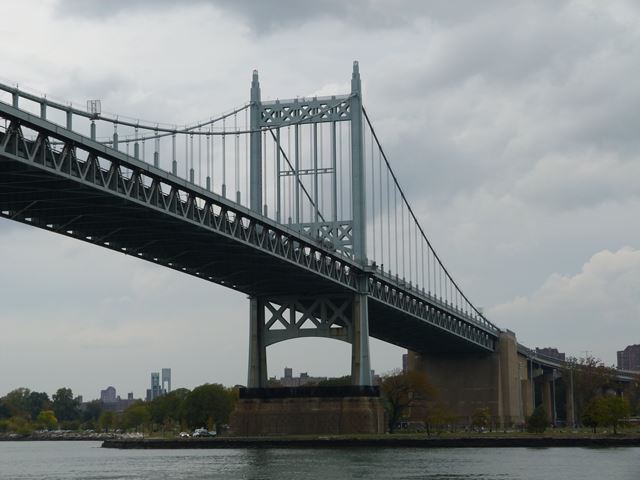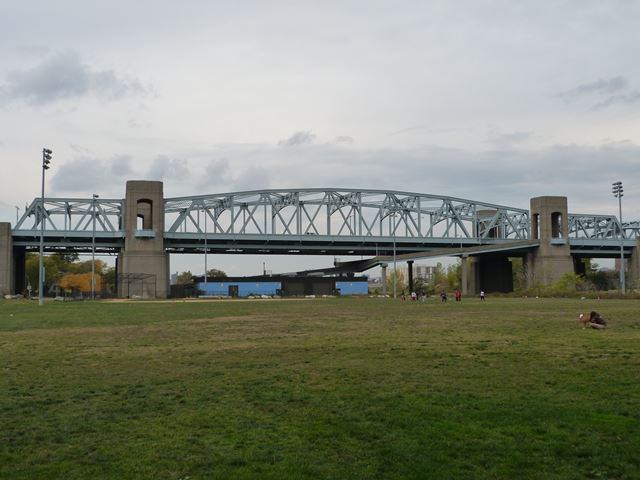We Recommend:
Bach Steel - Experts at historic truss bridge restoration.
Triborough Bridge
Robert F. Kennedy Bridge

Primary Photographer(s): Nathan Holth
Bridge Documented: October 20, 2013
I-278 Over East River, Harlem River, Bronx Kills, and Various Streets
New York: The Bronx, New York and Queens, New York and Manhattan, New York: United States
Metal Pony Truss Stiffening Wire Cable Suspension, Fixed and Approach Spans: Metal 12 Panel Rivet-Connected Polygonal Warren Through Truss, Movable: Vertical Lift (Tower Drive)
1936 By Builder/Contractor: American Bridge Company of New York, New York and Engineer/Design: Othmar Ammann
2004
1,380.0 Feet (420.6 Meters)
13,110.5 Feet (3996.1 Meters)
90.6 Feet (27.61 Meters)
3 Main Span(s) and 139 Approach Span(s)
5521889

View Information About HSR Ratings
Bridge Documentation
View Archived National Bridge Inventory Report - Has Additional Details and Evaluation
View Historic American Engineering Record (HAER) Documentation For This Bridge
View Historical Articles About This Bridge
This enormous bridge is really like three bridges and the discussion of the bridge has been divided accordingly below. Together, this Y-shaped bridge that crosses three different bodies of water and links three different boroughs is a unique bridge and one of the largest historic bridges in the country.
In 2008, the bridge was renamed to the Robert F. Kennedy Bridge. While its great to honor important public figures, one has to question the wisdom in doing this. Following renaming, all the guidance signs on the freeways reading "Triborough Bridge" were replaced with signs reading "Robert F. Kennedy Bridge." Perhaps in an era where people just blindly follow their GPS units and don't even bother looking at road signs this does not matter, but the old name, Triborough Bridge was highly descriptive. If you were lost in The Bronx and wanted to get to Queens, following signs for a bridge called the Triborough Bridge would seem like a safe bet. The name describes the function of the bridge of connecting three boroughs.
This website has additional information about this bridge.
East River Suspension Bridge
| East River Suspension Bridge Technical Facts |
| Total Length Between Anchorages | Largest Span Length | Design | Total Spans |
| 2780 Feet (847 Meters) | 1380 Feet (420.6 Meters) | Metal Pony Truss Stiffening Wire Cable Suspension, Fixed | 3 |
This is the largest and most visually impressive part of the bridge. A masterful suspension bridge design, its graceful cable lines and attractive stiffening truss geometry is complemented by Art Deco style detailing including finials at the top of the towers. At the southern end of the bridge, on the approaches there are also decorative concrete pillars with Art Deco style details. The tower design with horizontal lattice sections with a section of parallel, tall verticals is similar to the Vierendeel truss style of suspension bridge tower used on a number of bridges designed by another famous bridge engineer, David Steinman. Indeed, among the bridges designed by Othmar Ammann this is the most unlike his other work. Most of his other suspension bridges have a distinctively plain looking tower design with a solid arch design.
Harlem River Lift Bridge
| Harlem River Lift Bridge Technical Facts |
| Total Truss Length | Largest Span Length | Design | Total Spans |
| 770 Feet (234.7 Meters) | 310 Feet (94.5 Meters) | Metal 12 Panel Rivet-Connected Polygonal Warren Through Truss, Vertical Lift, Tower Drive | 3 |
The vertical lift bridge is a large and impressive structure. Its wide towers that are 210 feet tall tower over the rest of the bridge. Currently, HistoricBridges.org only has a few GoPro overview photos for this portion of the bridge.
Bronx Kills Through Truss Bridge
| Bronx Kills Through Truss Bridge Technical Facts |
| Total Truss Length | Largest Span Length | Design | Total Spans |
| 1600 Feet (487.7 Meters) | 383 Feet (116.7 Meters) | Metal 12 Panel Rivet-Connected Polygonal Warren Through Truss, Fixed and Approach Spans: Metal 10 Panel Rivet-Connected Warren Through Truss, Fixed | 7 |
This is perhaps the most unusual bridge of the three due to its design that predicted (incorrectly) that Bronx Kills would eventually become navigable. The spans over Bronx Kills on this bridge include a long polygonal Warren through truss flanked by heavy concrete piers and a very short through truss span. The ends of the short through truss spans at the ends that face the main span have vertical end posts. It makes the bridge look continuous when in fact these are three simple spans. The whole design was done like this so that the fixed bridge could later be converted into a vertical lift bridge. Towers would have been built on top of the short through truss spans. However, this development never happened, and indeed much the opposite happened, when Bronx Kills was mostly filled in with dirt.
Information and Findings From American Bridge CompanyDiscussion of 2004 Bridge Rehabilitation This joint venture project involved the complete re-decking of the existing 2,723' (830m) suspension bridge (1,380', 421m main span) with orthotropic deck panels and the 1,568' (478m) Queens Viaduct approach spans with precast concrete deck panels, the replacement of the 184 pairs of suspender ropes, and the widening of the Queens viaduct. The entire load of the three-span suspension bridge was transferred from the old hanger ropes to new ones in a carefully sequenced procedure developed by American Bridge. The ropes were removed and replaced using AB's scissor jack method, which greatly reduced the temporary loads which must be accommodated by adjacent hangers and truss members. The Queens Viaduct was widened from 116' (35.36m) to 129' (39.26m) by removing the existing 11'-5" (3,480mm) porkchops on the west side of the bridge and adding new 15' (4,572mm) porkchops that support a 17'-11" (5,460mm) deck on the west side. The existing concrete decks were cut and removed over the entire suspension bridge and viaduct structure, replaced with new orthotropic deck on the suspension bridge and precast deck on the viaduct. The orthotropic deck panels in the suspension bridge were welded longitudinally only. The transverse joints, which fall over existing floor beams form expansion joints, received a neoprene compression seal. The deck sections are approximately 10'-4" by 57' (3,148mm by 17,374mm) and weigh 22 tons (20mt). A total 252,000SF (23,412SM) of orthotropic deck panels were placed, with a weight of 7,560 tons (6,858.32mt). The viaduct panels are precast concrete units cast integrally with new crossbeams. Other work included the replacement of about 20 expansion joints, re-tightening of 1,900 cable band bolts, verification of 96 cable bands, pin replacements in the truss spans, installation of seismic restrainer brackets and cables in the viaduct, placement of new concrete barrier wall in the viaduct and steel barriers on the main span. |
![]()
Photo Galleries and Videos: Triborough Bridge
East River Spans Photo-Documentation
Original / Full Size PhotosA collection of overview and detail photos. This gallery offers photos in the highest available resolution and file size in a touch-friendly popup viewer.
Alternatively, Browse Without Using Viewer
![]()
East River Spans Photo-Documentation
Mobile Optimized PhotosA collection of overview and detail photos. This gallery features data-friendly, fast-loading photos in a touch-friendly popup viewer.
Alternatively, Browse Without Using Viewer
![]()
Harlem River Spans Photo-Documentation
Original / Full Size PhotosA collection of overview and detail photos. This gallery offers photos in the highest available resolution and file size in a touch-friendly popup viewer.
Alternatively, Browse Without Using Viewer
![]()
Harlem River Spans Photo-Documentation
Mobile Optimized PhotosA collection of overview and detail photos. This gallery features data-friendly, fast-loading photos in a touch-friendly popup viewer.
Alternatively, Browse Without Using Viewer
![]()
Bronx Kills Spans Photo-Documentation
Original / Full Size PhotosA collection of overview and detail photos. This gallery offers photos in the highest available resolution and file size in a touch-friendly popup viewer.
Alternatively, Browse Without Using Viewer
![]()
Bronx Kills Spans Photo-Documentation
Mobile Optimized PhotosA collection of overview and detail photos. This gallery features data-friendly, fast-loading photos in a touch-friendly popup viewer.
Alternatively, Browse Without Using Viewer
![]()
Maps and Links: Triborough Bridge
Coordinates (Latitude, Longitude):
Search For Additional Bridge Listings:
Bridgehunter.com: View listed bridges within 0.5 miles (0.8 kilometers) of this bridge.
Bridgehunter.com: View listed bridges within 10 miles (16 kilometers) of this bridge.
Additional Maps:
Google Streetview (If Available)
GeoHack (Additional Links and Coordinates)
Apple Maps (Via DuckDuckGo Search)
Apple Maps (Apple devices only)
Android: Open Location In Your Map or GPS App
Flickr Gallery (Find Nearby Photos)
Wikimedia Commons (Find Nearby Photos)
Directions Via Sygic For Android
Directions Via Sygic For iOS and Android Dolphin Browser
USGS National Map (United States Only)
Historical USGS Topo Maps (United States Only)
Historic Aerials (United States Only)
CalTopo Maps (United States Only)




